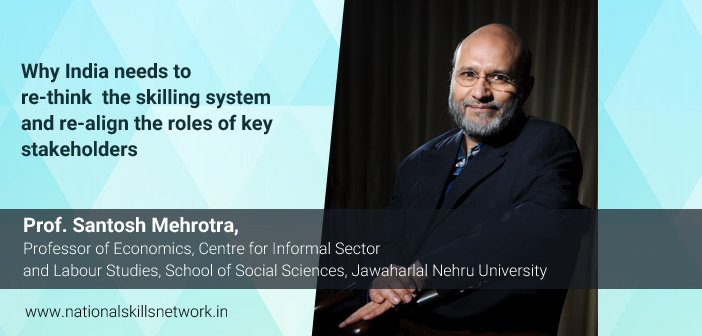We are delighted to present this exclusive Skill Talk by Prof. Santosh Mehrotra, Professor of Economics, Centre for Informal Sector and Labour Studies, School of Social Sciences, Jawaharlal Nehru University. Prof. Mehrotra has contributed immensely to the evolving skill development and VET system in India ever since its inception. It is our privilege to share his words of advice and perspective with regard to some critical aspects of skilling that include the role of various stakeholders, the need for a sound and sustainable financing mechanism and the necessity to re-think the current vocational training programs, curriculum, training content and duration. Let’s read on…
Roles and responsibilities of key stakeholders in skilling India
 Let me begin by saying that, at the global level, all effective VET systems have been driven by employers and industry and never been driven by the government. The role for the government is clear; first, regulate the private sector; second, ensure that the underprivileged and capability-deprived groups are able to access vocational training after finishing at least minimum schooling; and third, finance the marginalized and unorganised sector ensuring that the unorganised sector is provided with formally trained people. It is not that this sector is not doing skilling but they are doing informal apprenticeship for centuries where the young apprentices are hardly paid anything at all. Most importantly, Recognition of Prior Learning (RPL) is one of the areas where government can immediately take a few steps to make it impactful for the candidate and the industry.
Let me begin by saying that, at the global level, all effective VET systems have been driven by employers and industry and never been driven by the government. The role for the government is clear; first, regulate the private sector; second, ensure that the underprivileged and capability-deprived groups are able to access vocational training after finishing at least minimum schooling; and third, finance the marginalized and unorganised sector ensuring that the unorganised sector is provided with formally trained people. It is not that this sector is not doing skilling but they are doing informal apprenticeship for centuries where the young apprentices are hardly paid anything at all. Most importantly, Recognition of Prior Learning (RPL) is one of the areas where government can immediately take a few steps to make it impactful for the candidate and the industry.
Re-thinking Recognition of Prior Learning (RPL)
Today, the way RPL is being done, is highly ineffective and absurd. How can you train a person by giving some orientation in the morning, lunch in the afternoon and a certificate in the evening? I suggest two ways forward. First, I would argue that the 3 to 4 months short training like PMKVY should become RPL. That will be sufficient time to ensure that semi-literate or illiterate workers already in the workforce are imparted functional literacy; second, they are imparted some soft skills relevant for both unorganized and organized enterprise work; and finally their vocational skills are upgraded. That cannot take less than 3-4 months, since they already have vocational skills. This kind of RPL is needed for the 20+ year olds already in the labour force.
Second, for the young joining the labour force, who have just turned 15 (after finishing grade 8) or 17 (having just finished secondary schooling), it is necessary that proper vocational training should not be less than a year long. If conceptualised strategically, for the young the training should Include 9 months of theory and workshop plus 3 months of internship or industry experience. The young candidates should be imparted literacy and numeracy skills if they are illiterate along with soft skills (just like their older counterparts who are already in the labour force, who should be offered RPL).
 Looking back at how the Indian skilling system started and where we are going
Looking back at how the Indian skilling system started and where we are going
Skilling ecosystems can be classified into two: 1. The Germanic system, prevalent in Germany, Austria and German-speaking parts of Switzerland and to some extent in the Netherlands and 2. The Anglo-Saxon system. The Germanic model trains young people for broad occupations as against the Anglo-Saxon model that believes in training people for specific skills. There is a big difference between the two.
India has adopted the Anglo-Saxon model that has defined skills narrowly with least flexibility for the young trainee to switch from one job to another. But given that, in the 21st century when technology is changing all the time and our own economy is diversifying rapidly, forms of organisation are changing with the emergence of a platform economy, it’s absolutely critical that someone has the broad general academic education and also broad vocational education. Narrow training in specific skills will lock them into current job roles, without giving them an opportunity to grow.
Qualification Packs (QPs) and National Occupational Standards (NOS)
India has adopted the classification of occupation from the International classification which lists about 450 occupations across the globe. Now compare that with close to 2,000 Qualification Packs (QPs) and 10,000 National Occupational Standards (NOS) we’ve developed. How can we produce such a big number, when the International Classification itself has only 450! This shows how narrowly we’ve conceptualized skilling, influenced by the Anglo-Saxon system. Additionally, QPs and NOS were prepared by consultants and not employers. In fact this is one of the concerns we’ve raised in the Sharda Prasad Committee Report .
The training partners have mushroomed in great numbers thanks to the government financial support through NSDC, along with the setting up of private ITI s.10 years ago there were less than 2000 private ITI s and under 2,000 Govt ITI s (as per 11th plan). Though the government ITI s have increased by 300 – 400, the number of private ITIs has gone up from 2000 to 11,000. Does the government have the capacity to regulate the private institutions opening at the rate of 3 per day while they haven’t been able to regulate colleges/private tertiary education institutions opening at the rate of 4 per day since the year 2000? And in the case of NSDC funded training partners, the quality of training and placement is a big question. If the government plays the role of a financier then we’ve already lost focus on making training industry-relevant or demand-driven.
Role of the industry in skilling their workforce
For the system to be successful, industry has to be at the heart of the exercise to determine how many people should be skilled, in what occupation or trade since they are the ones who know what they want. How is the government supposed to know this? Apparently, the decision to train people in large numbers by offering short term skilling courses was driven by a desire to demonstrate that India (where only 2% of the workforce has formally acquired any vocational skills, based on National Sample Survey data), which needs, according to the National Skills Policy 2015 to train 400 million over 2012 to 2022, was training “millions” per annum now. However, training at break neck speed by providing short-term training t is not yielding the desired results. These youngsters are not getting jobs, or not jobs at wages that they feel justifies the skilling.
There are 3 ways to make skilling employer-driven:
- Industry has to identify how many people need to be skilled and in what trade .Employer should be engaged in design of the curriculum by specifying the competency levels.
- Industry is not doing this on a scale that is required.
- Industry should be willing to take pre- employment trainees by offering apprenticeship and internships in larger numbers.
Three imperatives of vocational training:
- Students must be taught theory of the occupation and not just a skill
- Students must be imparted hands-on workshop level practical training in a pre-employment setting
- Real industry experience should be an integral part of in pre-employment training unlike the present practice of post-training industry exposure.
In India, the students finish the training and then they come for industry experience unlike the German System where industrial training happens parallel with theoretical learning in the classroom.
The industry could play a meaningful role in assessment of the trainee because they know what skills or competence they are looking for and this is best done by the employer. Today, assessments are being conducted by standalone assessors who are accredicted by Sector Skill Councils (SSCs), that have little credibility and representation from the industry. In fact, many industry associations and major employers are not aware of the existence of SSCs!
Levy-based financing for skill development
Now let’s come to financing skill development. There are 62 countries in the world that have implemented a levy-based system where the government has a levy on the industry and the levy goes into a sectoral fund managed by the industry. Many European, African, Latin-American and 4 to 5 Asian countries have adopted this system to fund skilling. Brazil was one of the earliest to adopt it in 1942 with a levy of 1% and now it is 2% of the payroll.
The World Bank survey of enterprises for India in 2009 says only 16% of registered enterprises conducted any in-house Enterprise-based training and the same number rose to 36% in 2014. Most registered firms that conduct in-house training are large firms. This means Small and Medium Enterprises (SMEs) did not even conduct any training. This shows there is tremendous scope for registered SMEs to train and get reimbursements from the fund. They need to overcome the fear that if they train their workforce would get poached by others. If every firm conducts training, then there is no fear that trained workers of one firm will be poached by another firm looking for trained workers. Hence, the answer lies in the levy-based system that works for the good of the industry, particularly the SMEs, by solving the problem of skill deficit and shortage ofskilled workforce.
India has 2.5 million young people who are joining the workforce every year (not 12 million that many believe to be the case) looking for non-agricultural work because they have undergone schooling. However, with 3 to 4 months of skilling they will find it difficult to get jobs. What neither the government nor the individual trainee realise is that being half-educated and being quarter-skilled will make these youthful entrants into the labour force more frustrated. And this kind of frustration and anger could be a dangerous situation for our country.





Excellent Interview and the views of Prof. Santosh Mehrotra.